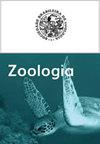两种同属鱼类生态形态和游泳性能的生态分离
IF 1.8
4区 生物学
Q4 ZOOLOGY
引用次数: 5
摘要
淡水鱼种类的多样性反映了其形态的可塑性。了解游泳能力,形态和栖息地利用之间的关系对于预测在人类环境中发现物种的机会可能很重要。本研究比较了两种同域物种的游泳能力和形态特征,并对它们在不同水力生境中的空间隔离进行了研究。捕获了21只1867年的fasciatum Reinhardt和23只1909年的characteridium cf. zebra Eigenmann,对其游泳能力和生态形态属性进行了评价。每个物种的游泳能力是通过测量临界速度和相对速度得到的。比较了与生境利用和游泳特征相关的12个生态形态属性。Mann-Whitney均值检验表明,纹状囊库的游泳能力大于纹状囊库,个体的标准长度解释了它们承受水流能力差异的12.42%。两种鱼尾柄的相对长度、腹侧平坦指数和胸鳍的相对面积在形态上存在差异,胸鳍的相对面积占抗水流能力差异的16.71%,不能用体长来解释。我们的研究结果表明,两种鱼类在生态形态空间和游泳能力上存在差异,这支持了水动力越大,鱼类承受水流的能力越强的假设,并且这种能力与鱼类游泳活动的形态特征相关。本文章由计算机程序翻译,如有差异,请以英文原文为准。
Ecological separation by ecomorphology and swimming performance between two congeneric fish species
The high diversity of freshwater fish species reflects a great morphological plasticity. Understanding the relationship between swimming capacity, morphology and habitat use may be important to predict the chances of finding a species at an anthropized environment. The swimming capacity and morphological aspects of two sympatric species of Characidium, and for which spatial segregation in different hydraulic habitats is known, were compared in this study. Twenty-one individuals of Characidium fasciatum Reinhardt, 1867 and 23 individuals of Characidium cf. zebra Eigenmann, 1909 were captured and used for the evaluation of the swimming capacity and ecomorphological attributes. The swimming capacity of each species was obtained by measuring critical and relative velocities. A total of 12 ecomorphological attributes correlated with habitat use and swimming characteristics were also compared. The Mann-Whitney mean test showed that the swimming capacity of C. fasciatum was greater than that of C. cf. zebra, and the standard length of the individuals explained 12.42% of the variation in their capacity to withstand water flow. Both species were morphologically distinct in the relative length of the caudal peduncle, ventral flattening index and the relative area of the pectoral fin. The relative area of the pectoral fin alone accounted for 16.71% of the differences in the ability to resist the water flow and which were not explained by body length. Our results showed that two species differed in the ecomorphological space and in their swimming capacity, supporting the hypothesis that the greater the hydrodynamism, the better a fish is able to withstand the water flow, and that this capacity is correlated with the morphological characteristics linked to the swimming activity of the fish.
求助全文
通过发布文献求助,成功后即可免费获取论文全文。
去求助
来源期刊

Zoologia
生物-动物学
自引率
0.00%
发文量
15
期刊介绍:
Zoologia, the scientific journal of the Sociedade Brasileira de Zoologia (SBZ), is an international peer-reviewed, open-access Zoological journal that publishes original research on systematics, evolution, taxonomy, nomenclature, biogeography, morphology, physiology, biology, ecology, symbiosis, conservation, behavior, genetics and allied fields. The journal, formerly known as Revista Brasileira de Zoologia, publishes original articles authored by both members and non-members of the Society. The manuscripts should be written exclusively in English.
 求助内容:
求助内容: 应助结果提醒方式:
应助结果提醒方式:


